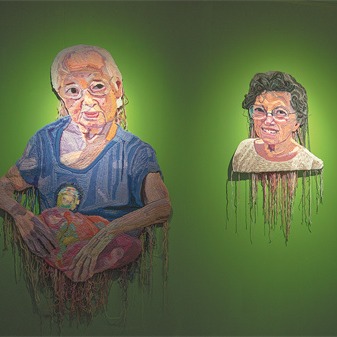



Exhibition shows daily materials taking on different forms and enriched meanings, Lin Qi reports.
A tapestry that examines changing attitudes toward interpersonal relations, under the impact of the COVID-19 pandemic, and a set of hanging bags, made of silk strips and painted in bright red, reflecting people's anxieties in a world of overconsumption, seem unlikely subjects for an exhibition.
Yet, these, and other materials — whether they have been used through the centuries or recently invented and brought into daily life — have been given a novel look at the exhibition titled Material Thinking in Beijing.
Through it, the audience can get a fresh sense of artistry and artisanship and embark on a journey trespassing time and cultural boundaries.

The exhibition, through to March 5, is the first biennale of contemporary material art mounted by Tsinghua University. It is being held at the Nanchizi Art Museum, a compound in the classic Chinese garden-style that comprises wooden windows, pavilions, long corridors, pools, strange hollow stones, courtyards and other structures to remind visitors of a serene residence in Suzhou, Jiangsu province. The space showing cultural traditions and the contemporary artworks on display have created a special chemistry.
The exhibition sourced works from artists around the world who endeavor vanguard explorations with materials. Besides those showing at Nanchizi, some others are on show at another exhibition under the same title in Qingdao, Shandong province, until Feb 27.
Ma Sai, dean of the Academy of Arts and Design, Tsinghua University, says the materials being used are commonly seen, such as metal, glass, fibers and plastics.
"These objects have been embedded with more dimensions and meanings by artists who have drawn from varying cultural backgrounds, social experiences and evolving international contexts," he says.

At the start of the exhibition is The Endless Line, an installation that South Korean artist Sun Young-kang had originally created as a commission for an international art project in his home. Cotton threads, mirrors, sugar and other materials were used to form several columns. The work was for a cultural park built at the former site of a sugar refinery, and the columns stand as the time channel to connect the site's past as a scaled industry construction with its present as a new venue of vigor and a bright future. The columns are a metaphor of people's belief in going through times of difficulty and blazing a trail.
Fibers, such as cotton, are a favored material for several artists at the exhibition. Jo Hamilton, born in Scotland and now living in Portland, the United States, worked for a social service organization for the elderly for some 14 years. She knitted portraits of woolen threads for the elderly under her care. The works from this series are on show in Beijing.
She learned to knit in childhood from her grandmother and mother. The colorful threads, the soft texture of the wool and the intimate atmosphere of knitting invigorate the women in her works, as if they are not aging.
Hamilton says she wanted to praise and care for people, especially those who normally will not become models for artworks. She has tried to capture particular moments of her subjects so that they will be understood to some extent by the strangers looking at the portraits.

Zhang Gan, the exhibition's chief curator, says the show is designed to bring warmth, closeness and healing, and the works will expose people to the fascination of material art and inspire them. He says the artists have engaged the audience in a discussion about existence and experience.
For a long time, many artists have been revisiting the theme of how modernity and other social changes are reshaping people's minds. Swiss artist Ursula Gerber Senger's work on show, Present Day Nomads III, is a group of human silhouettes made of iron wires and copper grids. She reveals an unstable, often trotting lifestyle, and a fragile inner side under an independent, strong outside of people, as they work and move around in a fast pace to keep up with the ever-changing world.
Peng Gang, vice-president of Tsinghua University, says he hopes the exhibition can motivate exchanges and research for artists and scholars from different countries, and by sharing the explorations of material art, people can learn from each other and build a human community with a shared future.
If you have any problems with this article, please contact us at app@chinadaily.com.cn and we'll immediately get back to you.